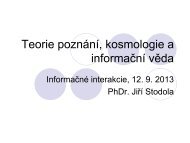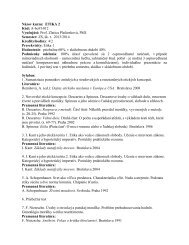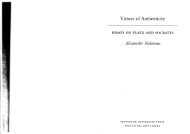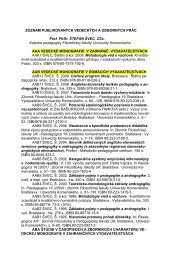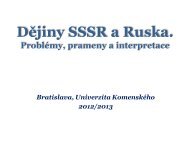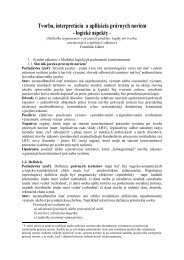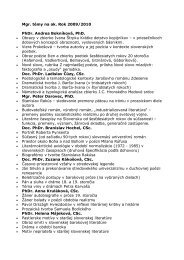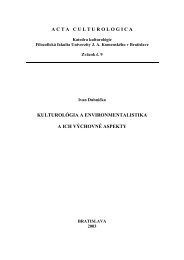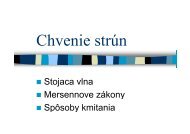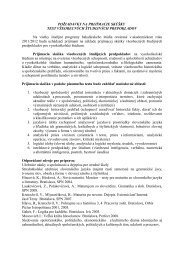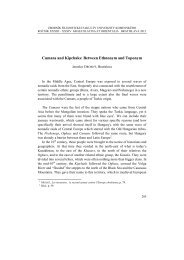Department of British and American Studies at the - Univerzita ...
Department of British and American Studies at the - Univerzita ...
Department of British and American Studies at the - Univerzita ...
Create successful ePaper yourself
Turn your PDF publications into a flip-book with our unique Google optimized e-Paper software.
caste girls into <strong>the</strong>ir households? Where have <strong>the</strong> rules <strong>of</strong> caste <strong>and</strong> religion fallen today<br />
[…]?‖ (ibid.: 236). Feeling punished for being ―stuck among Christians <strong>and</strong> me<strong>at</strong>-e<strong>at</strong>ers in<br />
this strange town‖ (ibid.: 232), Jayamma holds on to <strong>the</strong> stereotyped worldview. She does not<br />
change her opinion even after she finds out th<strong>at</strong> <strong>the</strong> Hoyka girl she despised is in fact a lonely<br />
little girl <strong>and</strong> <strong>the</strong> Brahmin boy th<strong>at</strong> she cared for behaves like a spoilt pr<strong>at</strong>.<br />
The concept <strong>of</strong> identity presenting it as a rigid, unchanging entity simply does not<br />
work for Shankara, Ziauddin <strong>and</strong> <strong>the</strong> o<strong>the</strong>r characters in <strong>the</strong> book. Wh<strong>at</strong> Adiga‘s narr<strong>at</strong>ive<br />
suggests about identity does definitely correspond with current trends <strong>and</strong> <strong>the</strong>ories in <strong>the</strong> field<br />
since <strong>the</strong>y both emphasize <strong>the</strong> elusiveness <strong>of</strong> identity <strong>and</strong> <strong>the</strong> impossibility to fix it. Of course,<br />
Adiga‘s portrayal <strong>of</strong> this m<strong>at</strong>ter is situ<strong>at</strong>ed in more or less absurd <strong>and</strong> even (tragi)comic<br />
circumstances, but <strong>the</strong> essence <strong>of</strong> <strong>the</strong> problem remains <strong>the</strong> same, i.e. it is impossible to fix<br />
identity in a particular place <strong>and</strong> time <strong>and</strong> keep it solid forever whe<strong>the</strong>r on <strong>the</strong> personal or on<br />
<strong>the</strong> n<strong>at</strong>ional level. India, presented through <strong>the</strong> microcosm <strong>of</strong> Kittur, seems to be as intangible<br />
as its inhabitants. The book is flooded with numerable references to various religious<br />
denomin<strong>at</strong>ions, caste divisions or n<strong>at</strong>ionalities. For a non-insider it is fairly difficult to<br />
orient<strong>at</strong>e within <strong>the</strong> intric<strong>at</strong>e Indian system <strong>of</strong> castes <strong>and</strong> religious denomin<strong>at</strong>ions which<br />
determine <strong>the</strong> social st<strong>at</strong>us <strong>of</strong> <strong>the</strong> members <strong>of</strong> <strong>the</strong>se groups respectively. Moreover, <strong>the</strong><br />
linguistic variety <strong>of</strong> <strong>the</strong> town working in accord with <strong>the</strong> caste <strong>and</strong> religious divisions are<br />
remindful <strong>of</strong> <strong>the</strong> chaotic organiz<strong>at</strong>ion <strong>of</strong> Babel.<br />
In conclusion, Between <strong>the</strong> Assassin<strong>at</strong>ions abounds in foreboding images <strong>and</strong><br />
portrayals. There seems to be no sense <strong>of</strong> a collective self th<strong>at</strong> would unite <strong>the</strong> town <strong>and</strong> its<br />
diversified inhabitants; <strong>the</strong> majority <strong>of</strong> <strong>the</strong> characters are egoistic individuals who are<br />
interested solely in <strong>the</strong>ir lives, not realizing th<strong>at</strong> without some unity no positive change can be<br />
achieved. Adiga‘s book, <strong>the</strong>n, does not provide a very optimistic portrayal <strong>of</strong> <strong>the</strong> multi-<br />
layered society; <strong>the</strong> stories depicting people struggling with irreversible poverty, corruption<br />
<strong>and</strong> with an unendurably str<strong>at</strong>ified environment imply th<strong>at</strong> <strong>the</strong>re is a dark ominous cloud<br />
hanging over India like <strong>the</strong> sword <strong>of</strong> Damocles.<br />
Bibliography<br />
ADIGA, Aravind (2009). Between <strong>the</strong> Assassin<strong>at</strong>ions. London: Atlantic Books.<br />
BAUMAN, Zygmunt (1996). From Pilgrim to Tourist – or a Short History <strong>of</strong> Identity. In<br />
Stuart Hall <strong>and</strong> Paul du Gay (Eds.), (2005). Questions <strong>of</strong> Cultural Identity (18 – 36).<br />
London/Thous<strong>and</strong> Oaks/New Delhi: Sage Public<strong>at</strong>ions.<br />
http://www.nyu.edu/classes/bkg/tourist/Baumann-pilgrim-tourist.pdf<br />
Slovak <strong>Studies</strong> in English, Vol. 3, 2011 – Identity in Intercultural Communic<strong>at</strong>ion<br />
154



